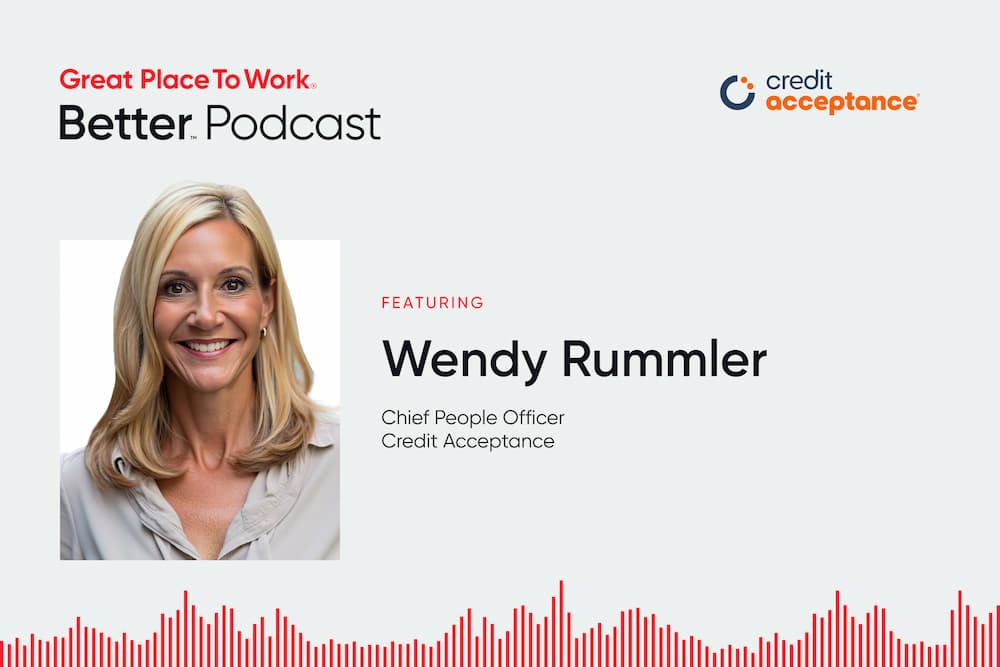
Changing company culture, Elements of Company Culture, Employee Experience, Employer Brand, Recruiting
How to ensure everyone in your workforce feels welcome and included.
When I joined UKG last April as the organization’s chief people officer, I knew building a purpose-driven culture and people strategy would require both authenticity and strategic planning. But being authentic wasn’t always easy for me. As an introvert, it’s only after years of practice that I learned to use my “voice.”
Today, I’m thrilled to build on UKG’s winning people strategy and share some of the lessons I’ve picked up along the way. Here’s what I’ve learned about scaling & building a high-performing, purpose-driven workplace culture:
1. How you welcome someone matters.
When I first started at UKG, I was invited to speak to our sales team. When I showed up, they rolled out this huge banner that said how excited they were that I was joining the organization. I knew UKG cared.
While creating a welcome banner for each new employee might not be realistic, it’s important to “get human” fast. Show employees you care by letting them know from day one that you’re ready for them to join the organization.
Think about those first impressions: setting up benefits, paychecks, and direct deposit. In those first 30 days, you want your employees to feel connected, to build friendships, and to have clearly defined goals.
2. It’s not about your title. It’s about “who you are.”
Our titles will change over time, but what an individual brings to the table every day matters. This includes being intentional about creating “memory moments” with co-workers. Memory gives you a shared experience, a sense of community, and a feeling that you’re not alone.
3. Create a culture that includes every employee.
Pursue diverse, inclusive cultures. If you create a sense of belonging for everyone, everyone benefits.
An employee’s purpose should align with the organization’s purpose. For example, my purpose statement is: “I need to leave the world better than I found it; to be kind; to give more than I get; to make a difference.” This complements UKG’s purpose to be “United, Kind, and Growing.” Together, we can do the right thing and make an impact.
4. Be adaptable.
An organization’s success depends on its ability to adapt. Leaders must be agile in their thinking and be adept problem solvers.
You will be more adaptable if you listen to and check on your employees. Pay attention to and gather insights throughout the employee lifecycle — from onboarding to offboarding. Do this by harnessing the power of technology to build in nudges and touch points. Is an employee adding a baby to their family? Do you need to stay in touch with a former intern? Use technology to add in those human layers.
5. People need freedom of choice.
Employees thrive when they have autonomy. It’s our job as leaders to guide people by giving them the right information and tools so that they can make the best decisions on their own. We all feel empowered when we have ownership. Then, we can create together.
6. We must train our managers.
Managers aren’t born to have all the skillsets. We must train them so they can be better owners and advocates for our employees.
This is key: Research shows that managers have more impact on your mental health than your primary care doctor.
7. Lead with transparency to build trust.
Don’t shy away from the difficult conversations. If you enter challenging conversations with care and compassion, the outcome will be better than if you avoid the conversation altogether. Lock arms with your leadership team to build a united front. You can’t be successful at this alone.
If you’d like to learn more strategies for creating a winning culture at your organization, check out my recent session “Creating a Culture of Purpose” from the HR & Payroll eSymposium where I discuss the employee experience journey, navigating employee expectations, creating connection, and more.
Subscribe & learn more about building and scaling a company culture
Learn how to create and scale an award-winning company culture. Subscribe to the Great Place To Work® company culture newsletter and join 100,000+ other leaders learning how to create a great workplace.










